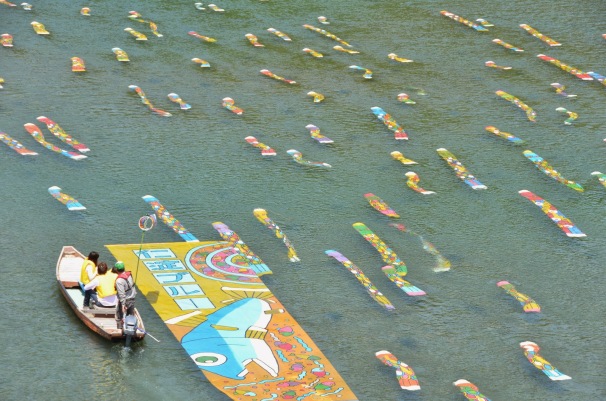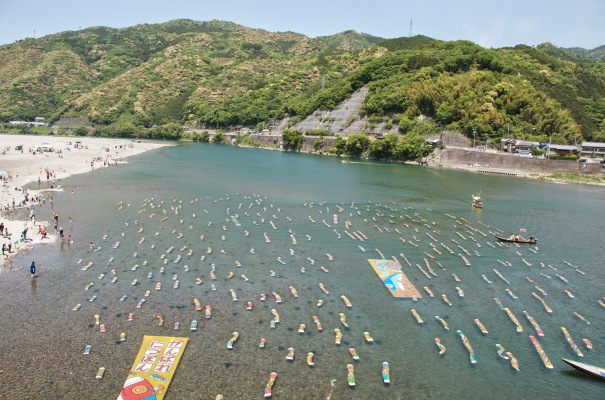![]()
Bergy Bit Paintings on Nepalese Paper
Artist’s Statement by J. J. L’Heureux
www.jjlheureux.com
“I am an abstract painter. I often use landscape as the inspiration for my work. The road from the physical environment to the inspiration on the canvas attempts to convey my enthusiasm and attraction to a place, its wildlife and selected aspects of the actual physical scenery.
Antarctica is remote, vast, windy and cold. Yet it is the most pristine place in all regards. It contains life in the most amazing forms and adaptations including penguins (birds that do not fly), birds that fly, seals, whales and in few places a handful of plants. While it is a place dominated by white on white there are colors in this setting of ice and snow that most people would be surprised to see.
Few people have had the privilege to travel to any part of this continent. There is a complex process underway among the many nations working in Antarctica of expanding the imagery of Antarctica into our shared cultural inventory of word, picture, music and scientific discovery.
Since my first visit thirteen years ago I have been building my own visual vocabulary. Bergy Bits is my first series of ice paintings. I have a photographic series that captures the colors and life in the snow and ice landscape. It is my intention to use different disciplines to capture my varied responses to this most wondrous place.
![]()
Close up look at Bergy Bits by J.J.
I have been to the Southern Ocean 13 times, the last in March 2013 when I was able to fly into the Taylor Dry Valley and study the Canada Glacier, one for the only “moving without movement” glaciers as it stays in approximately the same place because as it moves slowly forward it evaporates at the front inthe extremely windy, dry and extra cold air. It is my intention to find additional venues to explore different parts of this vast and inspiring place. The art will follow.
By definition Bergy Bits are large chunks of glacier ice or a very small iceberg floating in the sea. They are generally spawned from disintegrating icebergs and glaciers.”
We visited J.J.’s studio in late July, to see the Bergy Bits Series she was finishing up on. We were surprised to see how she incorporated the textured Nepalese papers into her work, using the bumpy textures of the papers to portray the coarse surfaces of the actual icebergs in the Southern Ocean. Over some coffee and J.J’s delicious homemade chocolate pudding, we asked her a few questions regarding her work:
Why did you choose to work with the Nepal papers for this series?
I loved the Nepal paper’s texture. I used to create my own bumpy textures on smooth papers, but when I found this Nepalese paper at Hiromi, it saved me a lot of trouble.
Do you go through any special preparations?
I have someone make the special size custom panels for me, then stretch the papers on to them and adhered with PVA glue. Then, I apply gesso before I start with my oil paints. I feel that oil paints have more texture than acrylic, which tends to become ‘flat’.
What is your main inspiration?
Well of course it comes from my expeditions to the South Ocean! Since 2000, I’ve been going every year on these adventures, and have been making art, conducting research and helping people ever since.
How long have you been using papers from Hiromi Paper?
Since Hiromi was at the Marina Del Rey location. She has the best papers, best variety and most availability. No one is disappointed with Hiromi’s Papers!
![]()
Check out our Nepal Paper here.
Thank You, J.J.!
![]()
![]()










 Since 1995 when the event started, hundreds of koinobori are gathered at the famous Niyodo River, where the townspeople and people around Japan come together to enjoy this annual celebration. The koinobori designs are all on unwoven cloth made locally, which are durable enough to be flown in the wind and ‘swim’ in the streams of Niyodo River. This unwoven cloth is an “in-between” of paper and cloth, since the synthetic fibers are bound together randomly like the characteristic of Japanese papermaking.
Since 1995 when the event started, hundreds of koinobori are gathered at the famous Niyodo River, where the townspeople and people around Japan come together to enjoy this annual celebration. The koinobori designs are all on unwoven cloth made locally, which are durable enough to be flown in the wind and ‘swim’ in the streams of Niyodo River. This unwoven cloth is an “in-between” of paper and cloth, since the synthetic fibers are bound together randomly like the characteristic of Japanese papermaking.
 People can choose to see the swimming koinobori up-close on small boats!
People can choose to see the swimming koinobori up-close on small boats!
















![_DSC7752[2]](http://hiromipaper.files.wordpress.com/2014/07/dsc775221.jpeg?w=500&h=331)












 (Original Japanese article can be found
(Original Japanese article can be found 







 The goal is to make 100 paper lanterns, and the finished art work will be displayed at an exhibition called BRIDGELIGHTS @ Circus Latino, Sept. 18 – 20 in Sleepy Hollow, NY.
The goal is to make 100 paper lanterns, and the finished art work will be displayed at an exhibition called BRIDGELIGHTS @ Circus Latino, Sept. 18 – 20 in Sleepy Hollow, NY. Anyone, ages 12-120, is invited to come carve portraits or family names/origins, which we’ll print on beautiful handmade Bhutanese paper.
Anyone, ages 12-120, is invited to come carve portraits or family names/origins, which we’ll print on beautiful handmade Bhutanese paper.































